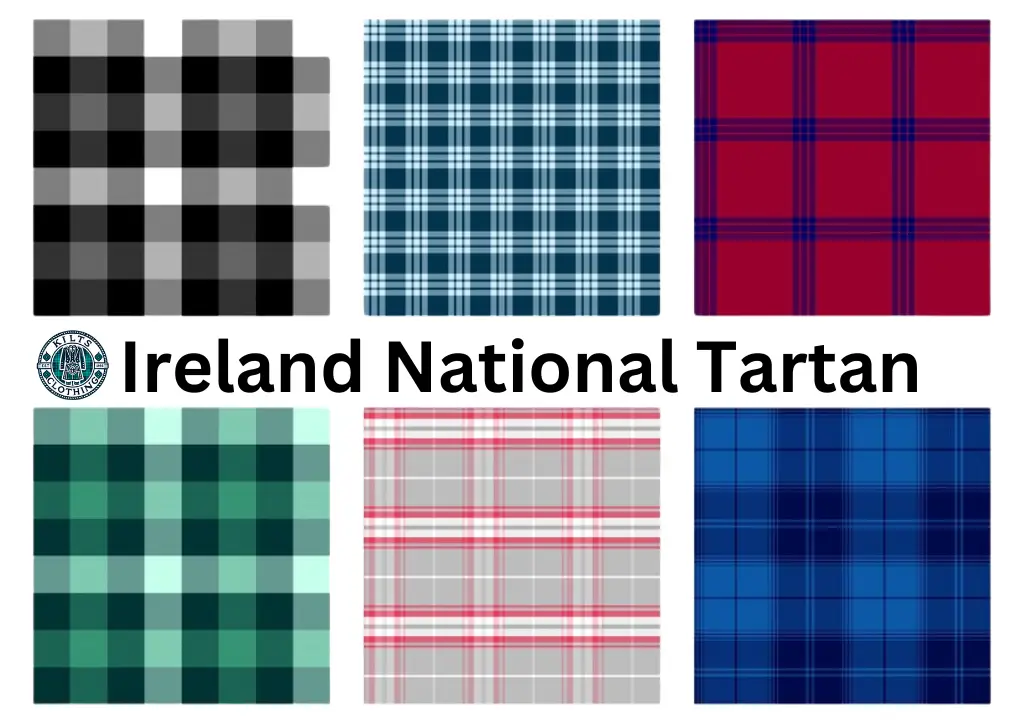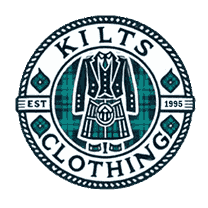A Guide to Ireland National Tartan: Origins and Patterns

Introduction to Ireland National Tartan
The Ireland traditional kilt is more than just a fabric; it is a vibrant symbol of Irish heritage and national pride. This patterned cloth, woven with distinct colors and designs, reflects the rich history and traditions of Ireland. While tartan is often associated with Scotland, Ireland has its unique connection to these iconic patterns, rooted deeply in Celtic culture.
The Ireland National Tartan embodies the unity and spirit of the Irish people, serving as a visual representation of their collective identity. This connection to tartan kilt is a testament to the deep historical ties and the enduring cultural significance that it holds in Ireland.
The Origins of Irish Tartan
The history of traditional kilt in Ireland is intertwined with the country's Celtic past. Long before the tartan became synonymous with Scottish clans, Celtic tribes in Ireland were using woven patterns to signify their identity and status. These early tartan designs were likely influenced by the natural environment, with colors derived from local dyes.
Over time, as Ireland's ties with Scotland strengthened, particularly through the migration of the Scots-Irish, Irish tartan patterns began to reflect a blend of influences. This included traditional Celtic motifs and elements of Scottish tartan, showcasing a fusion of cultural traditions that have shaped the modern Irish tartan.
Understanding Tartan Patterns
Tartan patterns are more than just a series of crisscrossing lines; they are a form of symbolic art. Each pattern, known as a sett, is unique, combining specific colors and arrangements to convey meaning. The process of tartan design involves carefully selecting these colors, each of which holds significance.
For instance, green is often used to represent the lush landscapes of Ireland, while blue might symbolize the surrounding seas. The way these colors are woven together in a tartan pattern tells a story of the wearer's heritage and ancestry, making each design deeply personal and culturally rich.
Tartan and Irish National Identity
Tartan plays a crucial role in expressing Irish national identity. While many associate tartan with Scottish clans, Irish tartan patterns are equally important in symbolizing belonging and pride. Each tartan design can be linked to specific Irish families or regions, creating a sense of unity among those who share the same heritage.
The Ireland National Tartan, in particular, is a symbol of unity for all Irish people, representing a collective identity rooted in shared history and cultural pride. This connection to tartan is a way for the Irish to maintain and express their unique cultural identity, both within the country and around the world.
Traditional Irish Tartan Designs
Traditional Irish tartan designs are distinct, yet they share some common features with Scottish tartan. These designs often incorporate colors like green and blue, symbolizing the Irish landscape and the connection to the sea. Earthy tones such as brown and gold add depth, reflecting the richness of Irish culture.
One notable design is the St. Patrick's Tartan, which includes blue, green, white, and gold. This tartan is often associated with St. Patrick's and is worn during celebrations, symbolizing Irish heritage. These traditional kilt pattern tartan are not only visually striking but also carry deep cultural significance.
Celtic Tartan: A Link to the Past
Celtic tartan serves as a powerful link to Ireland's ancient past. These patterns often incorporate Celtic knotwork, a design element that symbolizes eternity and the interconnectedness of life. Celtic tartan is not just decorative; it carries deep symbolic meaning, often representing themes of life, death, and rebirth.
The influence of Celtic art on tartan design is evident in the use of spirals, knots, and other motifs, all woven into the fabric as a reminder of Ireland's spiritual and cultural roots. This connection to the past is a testament to the enduring legacy of Celtic traditions in Ireland.
Tartan Weaving Techniques
The art of tartan weaving in Ireland has been passed down through generations. Traditional tartan weaving techniques require skill and precision, with the weaver carefully aligning the warp and weft threads to create distinctive crisscrossed patterns. Irish tartan is typically woven from high-quality wool, a material that has been central to Irish textile manufacturing for centuries.
The process of creating a tartan involves the following:
- Setting up a loom.
- Arranging the threads according to the desired pattern.
- Weaving them together to form the tartan fabric.
This meticulous process ensures that each piece of tartan is a work of art, reflecting both craftsmanship and tradition.
Tartan in Irish Traditional Clothing
Tartan has long been a staple in traditional Irish clothing, and it is used in a variety of garments such as tartan kilts for men, shawls, and cloaks. Historically, tartan clothing was not only functional but also a way to display one's heritage and social status. The patterns and colors of these garments were often associated with specific regions or families, serving as a form of identification.
Today, tartan remains an important element of Irish dress, especially during cultural events and celebrations. It symbolizes a connection to the past and pride in Irish identity. The continued use of tartan in clothing is a testament to its enduring significance in Irish culture.
The Symbolism of Tartan Colors
The colors in Irish tartan patterns are carefully chosen for their symbolic meanings. For example, green represents Ireland's lush, rolling hills, while blue often symbolizes the sea that surrounds the island. Gold may reflect the wealth of Irish cultural heritage, and brown could signify the earth or peat bogs.
These colors are not just decorative; they convey stories and traditions, making tartan a powerful medium for expressing Irish identity and history. The careful selection of these colors ensures that each tartan pattern is rich in meaning and cultural significance.
Irish Heritage Tartan Today
In recent years, there has been a revival of Irish tartan designs, with renewed interest in these patterns as symbols of heritage and identity. Modern designers are incorporating Irish tartan into contemporary clothing and accessories, blending traditional motifs with modern fashion trends. This revival has helped to keep the tradition of tartan alive, ensuring that it remains a relevant and cherished part of Irish culture.
This renewed interest in Irish tartan has also sparked efforts to educate the public about the history and significance of these patterns. By integrating tartan into modern fashion, designers are able to connect the past with the present, making Irish tartan a living part of today's cultural landscape.
Tartan Clan Connections
Many Irish tartan patterns are linked to specific clans or families, serving as a visual representation of their heritage. These patterns are often passed down through generations, connecting the present with the past. The tartan worn by a particular clan can reveal a lot about its history and origins, making it an important symbol of family pride and ancestry.
These tartan designs reflect family heritage and serve as a means of preserving and promoting Irish cultural identity. The continued use of tartan within clans ensures that these patterns remain a vital part of Ireland's cultural heritage.
Tartan Textiles and Materials
The materials used in tartan weaving are crucial to the quality and durability of the final product. Irish wool, known for its warmth and resilience, is a popular choice for tartan fabric. Textile manufacturing in Ireland has a long history, with skilled craftsmen ensuring that the traditions of tartan weaving are preserved and passed on to future generations.
This focus on quality materials and traditional methods ensures that each piece of Irish tartan is not only beautiful but also durable, capable of being passed down as a family heirloom. The commitment to using high-quality materials reflects the importance of tartan in Irish culture and its role in maintaining cultural traditions.
Irish Tartan in Fashion
Irish tartan has made a significant impact on global fashion trends, with designers incorporating these traditional patterns into their collections. The blend of heritage and modernity makes Irish tartan a versatile element in fashion, allowing it to be used in everything from formal wear to casual attire. This adaptability has ensured that tartan remains a popular and enduring aspect of Irish culture.
The presence of Irish tartan in contemporary fashion not only highlights its aesthetic appeal but also serves to keep the tradition of tartan alive. By merging traditional patterns with modern styles, designers are able to introduce Irish tartan to new audiences, ensuring its continued relevance.
Tartan Plaid and Irish Craftsmanship
The creation of tartan plaid requires a high level of craftsmanship, with skilled weavers playing a vital role in maintaining the tradition. The process involves more than just weaving threads together; it requires an understanding of tartan patterns, color symbolism, and the cultural significance of the fabric.
The artistry involved in making tartan plaid is a testament to the dedication and skill of Irish artisans. These artisans ensure that each piece of tartan is a work of art, reflecting the rich history and traditions of Ireland.
Preserving Tartan Heritage
Efforts to preserve and promote Irish tartan are crucial for maintaining this important aspect of national identity. Organizations and cultural groups work tirelessly to ensure that the traditions associated with tartan are passed down to future generations. These efforts help to keep the symbolism and heritage of Irish tartan alive, making it a living part of Ireland's cultural landscape.
By focusing on education and cultural preservation, these organizations ensure that the rich history of Irish tartan is preserved. Their work plays a vital role in maintaining Irish cultural identity and passing it on to future generations.
Conclusion:
The future of Irish traditional kilt remains bright as it continues to symbolize national identity and cultural heritage. With growing interest both in Ireland and globally, there's a renewed appreciation for the rich history and craftsmanship behind these patterns. The Ireland National Tartan stands out as a unifying symbol, connecting people to their Celtic roots and shared traditions while also finding new life in modern fashion and culture.
Efforts to preserve Irish tartan focus not only on maintaining the patterns but also on passing down the stories and skills behind them. As more people recognize the significance of Irish tartan, there's a strong movement to educate future generations about its importance. This commitment ensures that Irish tartan will remain a cherished symbol of Irish identity for years to come.
FAQs
Irish tartan originated with Celtic tribes in Ireland, who used woven patterns to signify identity and status. Scottish tartan designs later influenced these patterns.
The tartan pattern originated with the Celtic people in the regions that are now Scotland and Ireland. It was used primarily to identify different clans or families.
To find your Irish clan tartan, research your family history and surname through tartan databases or consult with Irish heritage organizations.
The kilt in Ireland has roots in traditional Celtic clothing, with garments like the léine and brat evolving over time into what is now considered traditional Irish dress.
Irish tartans often feature green, blue, and earthy tones reflecting Ireland’s landscapes, while Scottish tartans use a broader range of colors and are closely tied to specific clans.
Yes, non-Scots can wear tartan, a global symbol of Celtic heritage. Many universal or national tartans, like the Ireland National Tartan, are available for anyone to wear.



